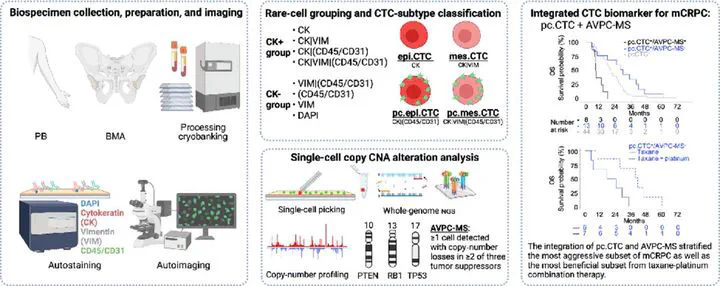Platelet-Coated Circulating Tumor Cells Are a Predictive Biomarker in Patients with Metastatic Castrate-Resistant Prostate Cancer
Dec 19, 2021·,,,,,,,,,, ,,,,,,·
0 min read
,,,,,,·
0 min read
Shoujie Chai
Nicholas Matsumoto
Ryan Storgard
Chen-Ching Peng
Ana Aparicio
Bemjamic Ormseth
Kate Rappard
Katherine Cunningham
Anand Kolatkar
Rafael Nevarez
Kai-Han Tu
Ruu Hsu
Paymaneh Malihi
Paul Corn
Amado Zurita
James Hicks
Peter Kuhn
Carmen Ruiz Velasco

Abstract
Metastatic castration-resistant prostate cancer (mCRPC) includes a subset of patients with particularly unfavorable prognosis characterized by combined defects in at least two of three tumor suppressor genes: PTEN, RB1, and TP53 as aggressive variant prostate cancer molecular signature (AVPC-MS). We aimed to identify circulating tumor cells (CTC) signatures that could inform treatment decisions of patients with mCRPC with cabazitaxel-carboplatin combination therapy versus cabazitaxel alone. Liquid biopsy samples were collected prospectively from 79 patients for retrospective analysis. CTCs were detected, classified, enumerated through a computational pipeline followed by manual curation, and subjected to single-cell genome-wide copy-number profiling for AVPC-MS detection. On the basis of immunofluorescence intensities, detected rare cells were classified into 8 rare-cell groups. Further morphologic characterization categorized CTC subtypes from 4 cytokeratin-positive rare-cell groups, utilizing presence of mesenchymal features and platelet attachment. Of 79 cases, 77 (97.5%) had CTCs, 24 (30.4%) were positive for platelet-coated CTCs (pc.CTCs) and 25 (38.5%) of 65 sequenced patients exhibited AVPC-MS in CTCs. Survival analysis indicated that the presence of pc.CTCs identified the subset of patients who were AVPC-MS-positive with the worst prognosis and minimal benefit from combination therapy. In AVPC-MS-negative patients, its presence showed significant survival improvement from combination therapy. Our findings suggest the presence of pc.CTCs as a predictive biomarker to further stratify AVPC subsets with the worst prognosis and the most significant benefit of additional platinum therapy. IMPLICATIONS: HDSCA3.0 can be performed with rare cell detection, categorization, and genomic characterization for pc.CTC identification and AVPC-MS detection as a potential predictive biomarker of mCRPC.
Type
Publication
Molecular Cancer Research